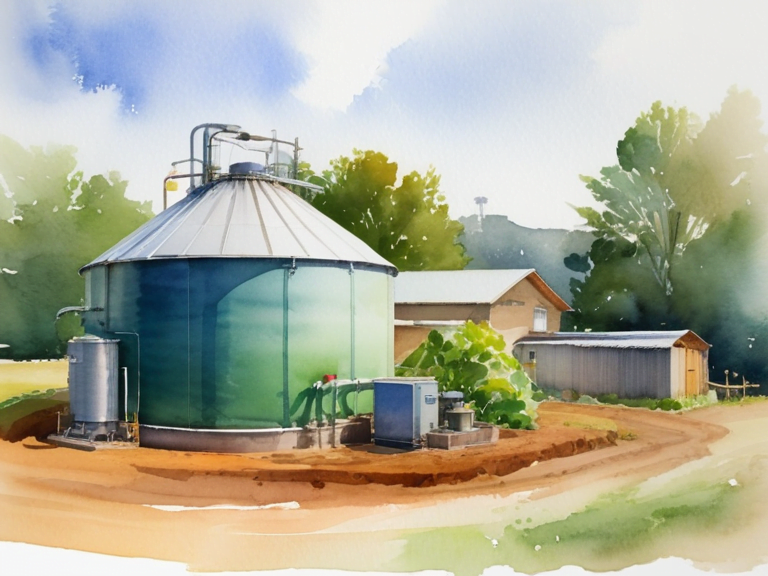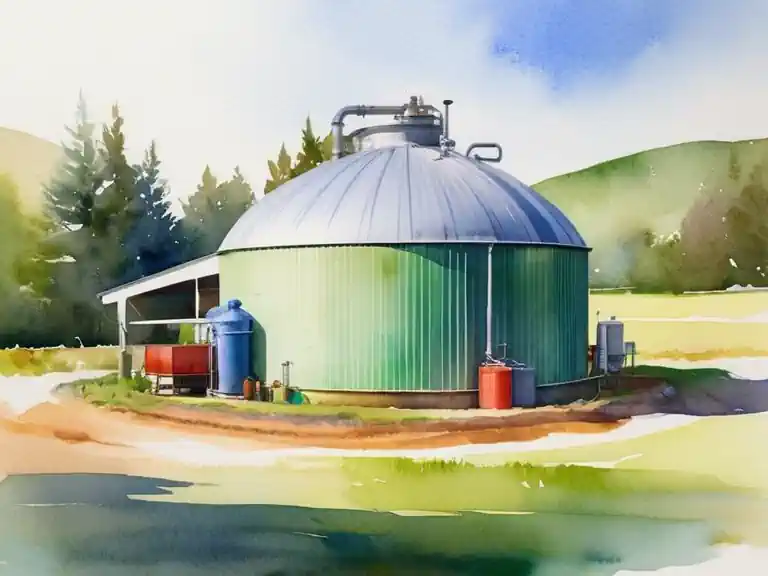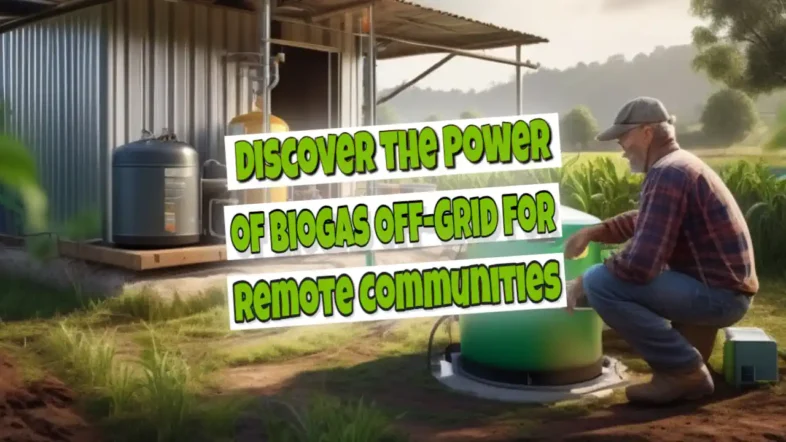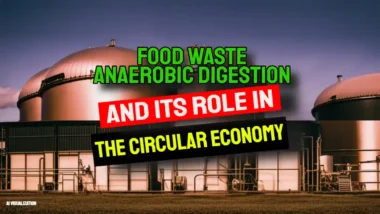Here's our guide to biogas off-grid for all remote communities.
Living off the grid in remote areas can be tough, especially when it comes to energy needs. Many off-grid homeowners struggle with finding reliable and sustainable sources of power for cooking, heating, and electricity.
This challenge often leads to a heavy dependence on costly generators or unsafe burning of wood.
One efficient solution is biogas, which converts organic waste into clean energy. 3 Systems like HomeBiogas transform food scraps into cooking gas and produce bio-fertiliser for gardens.
This not only cuts expenses but also helps manage waste effectively. 1
In this blog post, we will explore how biogas systems work and their benefits for off-grid communities. You'll learn how these systems can make life easier and more sustainable far from the city lights.
Stay tuned!
Biogas Off-Grid Key Takeaways
- Biogas off-grid systems convert organic waste into clean, renewable energy suitable for cooking, heating, and generating electricity in remote off-grid communities.
- By using biogas, communities can significantly reduce carbon dioxide emissions. For example, a hybrid PV/Biogas/Battery system in Morocco cut CO2 emissions by 40%.
- Setting up a HomeBiogas digester costs $720 plus shipping and provides long-term savings by reducing the need for traditional fuels like wood or gas.
- Educational programmes and skills training are essential for effective biogas adoption. These include hands-on learning and troubleshooting to empower locals.
- Government support through fiscal incentives and policy frameworks is crucial. Initiatives like Pakistan’s promotion of biogas facilities help make this technology accessible to rural areas.
Exploring the Benefits of Biogas for Remote Off-Grid Communities

Biogas offers many benefits to remote off-grid communities. It provides a clean and reliable source of energy without harming the environment.

Renewable Energy Source
Biogas offers a green alternative for off-grid homes. It's primarily made from methane and carbon dioxide, making it an excellent renewable energy source. This type of fuel helps cut down on the use of fossil fuels and lowers your carbon footprint. 1
The European Union has pushed for biogas since the 1990s to achieve net-zero greenhouse gas emissions by 2050. Biomass, which includes biogas, is one of Earth's most plentiful resources.
Using biogas can bring remote communities closer to cleaner cooking and heating solutions. 2
“Switching to renewable energies like biogas ensures a healthier planet for future generations.”
Carbon Emission Reduction
Using biogas can significantly cut down carbon emissions. The hybrid PV/Biogas/Battery system in Morocco decreased carbon dioxide emissions by 40%. 3 Off-grid communities switching from LPG to biogases contribute less methane and black carbon into the air. 4 Livestock farms, a major source of methane, also benefit as waste gets turned into clean cooking gas.
Cleaner energy means healthier air for all. Methane is harmful to our environment. Reducing it helps combat climate change and supports greener living. Biogas provides a renewable solution fitting within net zero goals set by agreements like Paris Accord to limit global warming's impact.
Enhanced Waste Management
Portable biogas plants offer an innovative solution for waste management. They can reduce landfill waste and cut down on environmental hazards and bad smells. These systems convert organic materials into biogas using anaerobic digestion, which consists mainly of methane and carbon dioxide. 5
Ontario produces 4 million metric tonnes of organic waste each year. Biogas systems recycle this material, turning it into useful energy while lowering emissions and saving fossil fuels.
This process diverts food waste from landfills, helping off-grid communities manage their waste better while generating clean energy. 3
Operational Mechanisms of Biogas Systems
Biogas systems turn organic waste into useful energy. This process involves capturing gases like methane from decomposing materials in a biodigester.

Conversion of Organic Waste to Energy
Anaerobic digestion transforms organic waste into clean energy. HomeBiogas systems can handle up to 12 litres (3 gallons) of waste daily, producing enough biogas for cooking and heating. 6 To get two hours of high-flame cooking, simply add 6 litres (1.5 gallons) of kitchen scraps each day.
Fresh animal manure is another option for fuel, requiring about 20 litres (5 gallons) to achieve the same cooking time. 7 These systems work best in warm climates with temperatures around 20°C (68°F).
This process helps off-grid homes manage waste efficiently and creates a closed-loop system.
Turning kitchen scraps into energy is like magic! My HomeBiogas system keeps my stove flaming hot using just veggie peels. — An off-grid home owner
Applications of Biogas: Cooking, Electricity, Heating
Biogas offers many uses for off-grid homes. It provides energy for cooking, electricity, and heating.
- Cooking:
- The Home Biodigester turns food scraps into biogas.
- This gas burns cleanly with a blue flame, much like LPG or natural gas.
- Off-gridders can use it in their kitchen stoves without smoke or soot.
- Electricity:
- Combined Heat and Power (CHP) systems generate both heat and electricity from biogas. 8
- Over 90% of biogas produced generates power and heat globally.
- Biogas can run generators to provide adequate power for lights, appliances, and tools.
- Biogas can warm homes during cold periods through special heaters.
- These heaters utilise the clean-burning nature of biogas for effective warming.
- Steady heating enhances comfort while saving on traditional fuel costs.
Using biogas systems enhances self-sufficiency and sustainability, perfect for off-grid living! 9
Strategies for Biogas Implementation in Remote Off-Grid Areas
Remote off-grid areas need proper infrastructure for biogas systems. They also benefit economically from energy savings and renewable resources.

Infrastructure Requirements and Logistics
Biogas offers great potential for off-grid communities. Planning and setup are crucial to make it work well. 3
- Infrastructure Needs:
- Anaerobic Digesters: These machines convert organic waste into biogas. They need space and proper installation.
- Pipes and Tubes: Biogas systems require strong tubing for transporting gas.
- Bio-toilets: Adding bio-toilets can help with waste removal and gas production.
- Cooking Stoves: Special stoves are needed to use biogas for cooking.
- Logistical Requirements:
- Transportation of Materials: Getting materials to remote areas can be tricky. Plan the routes and consider transport options. 10
- Installation Team: Skilled workers must handle the installation. Training local people is a good idea too.
- Monitoring Equipment: Set up devices to track energy production and usage.
- Coordination Efforts:
- Stakeholder Communication: Work closely with all parties involved, like suppliers and community leaders.
- Risk Assessment: Look at possible risks and plan how to manage them.
- Economic Factors:
- Consider initial costs and long-term savings. Biogas systems save money over time by reducing the need for other fuels.
- Environmental Benefits:
- Lower carbon emissions from using renewable energy improve air quality.
- Community Involvement:
- Educate locals about the benefits of biogas through workshops or training sessions.
- Policy Support:
- Lobby for government incentives to support biogas projects in off-grid areas.
Careful planning, coordination, and execution can make biogas systems effective in remote locations. 10 Thorough risk assessment improves success chances while regular monitoring ensures efficiency benefits both economically and environmentally.

Economic Benefits and Impacts
Transitioning from the infrastructure requirements, let's discuss how biogas can boost local economies. Installing a HomeBiogas digester 2.0 system costs $720, plus shipping. Once set up, it turns organic waste into energy.
This cuts down expenses on traditional fuels like wood or gas.
Investing in biogas contributes to both economic growth and environmental health. 11
In Morocco, a hybrid PV/Biogas/Battery system slashed CO2 emissions by 40%. 2 Such improvements not only help the earth but also attract investments. Lower energy costs mean more money for other needs like food production or tiny house projects.
Remote communities can thrive with sustainable living choices while saving six tons of carbon emissions each year.
Assessing Environmental Benefits
Biogas systems offer significant environmental benefits for remote off-grid communities. These systems help cut carbon emissions, as evidenced by the 40% CO2 reduction achieved with a hybrid PV/biogas/battery system in Morocco. 2 By converting organic waste into energy, biogas reduces methane emissions from traditional animal manure management. 12
Producing bio-slurry fertiliser provides essential nutrients like nitrogen and potassium, promoting sustainable food production. This approach saves time and labour compared to composting piles.
Reduced reliance on fossil fuels also conserves natural resources, supporting a green lifestyle and fostering a circular economy.
Next, let's explore the operational mechanisms of biogas systems…
Addressing Challenges and Proposing Solutions for Biogas Adoption
Lowering costs makes biogas affordable for all. Skills training helps people use and maintain the system. Support from the government boosts adoption rates. Raising community awareness fosters engagement.
Read on to learn more about how we can make biogas work in remote areas!
Managing Costs and Enhancing Affordability
Biogas offers a practical solution for off-grid communities. Managing costs and making it affordable helps many families adopt this technology.
- Start with HomeBiogas 2.0: The HomeBiogas digester 2.0 costs $720 plus shipping, making it an affordable option for many households.
- Use Hybrid Systems: Integration of hybrid PV/Biogas/Battery systems can lower overall expenses, providing a reliable energy mix.
- Invest in Skilled Technicians: Having skilled technicians ensures smooth operation and less frequent maintenance issues, saving on long-term costs. 11
- Consider Carbon Credits: Economic benefits include potential carbon credits, which can offset initial investments.
- Tap into Government Incentives: Governments prioritising investment in biogas plants can offer subsidies or tax breaks, reducing upfront costs for homeowners. 13
- Maximise Waste Recycling: Using kitchen waste and animal manure reduces the need to purchase raw materials, cutting down operational expenses.
- Community Training Programmes: Local educational programmes teach proper use and maintenance of biogas systems, ensuring efficient operation without extra cost.
- Evaluate Energy Needs: Assessing your household's energy requirements allows for the right size and type of biogas system, avoiding overspending on unnecessary features.
- Plan for Long-Term Savings: Reduced fuel expenses from using biogas instead of traditional fuels contribute to long-term financial benefits.
- Seek Local Resources: Collaborating with local suppliers to source parts and support services can further reduce implementation costs by minimising logistics expenses.
Educational Programmes and Skills Training
Educational programmes and skills training are crucial for adopting biogas in remote off-grid communities. These efforts cover various disciplines and equip participants with essential skills.
- Comprehensive Training
Participants gain operational, technical, engineering, and managerial skills necessary for biogas projects. This ensures the effective use of biogas systems. 14 - Collaboration with Schools
Private sector companies partner with schools to develop relevant courses. These collaborations enhance learning opportunities and practical training. 14 - Troubleshooting Skills
Educational programmes focus on troubleshooting and maintenance. This empowers community members to handle issues independently. - Funding by Private Sector
Companies contribute funds to support training initiatives. This financial backing helps sustain and expand educational efforts. - Diverse Participation
Community members, technicians, policymakers, researchers, and farmers participate in these programmes. Such diverse involvement fosters a comprehensive understanding of biogas systems. - Hands-on Learning
Programmes include practical sessions where learners operate biogas systems themselves. This hands-on experience builds confidence and expertise. - Community Engagement
Educating the community about energy security and environmental impact strengthens engagement. Awareness is key to the successful implementation of biogas technology. 15

Policy Support and Government Incentives
Government policies play a key role in biogas adoption. Pakistan's government has taken steps to boost biogas facilities. 11 These measures are crucial for economic growth in rural regions.
A strong policy environment helps spark innovations in biogas technology.
Fiscal incentives also encourage private-sector investment. This can lower costs and make biogas systems more affordable for off-grid communities. Supporting the Biogas Support Programme (BSP) across rural areas is vital. 16 With these initiatives, energy issues can be addressed, promoting sustainable living through nutrient recycling and biomethane extraction.
Fostering Community Engagement and Awareness
Engaging the community ensures successful biogas projects. Wastewater treatment plants (WWTP) can boost regional sanitation and economic growth. 17 Co-digestion of organic wastes like food scraps and animal manure increases biogas production, making it more efficient.
Public-private partnerships play a vital role in raising awareness and promoting biogas technology.
Organising workshops or local meetings can educate off-grid homeowners about the benefits of biogas. Educational programmes offer skills training to manage these energy systems efficiently.
Local conditions must be assessed to tailor solutions that fit specific needs, ensuring project success in remote areas. 15
Biogas Off-Grid Conclusion
Biogas transforms waste into valuable energy. This process supports off-grid communities in many ways. It reduces carbon emissions and manages waste more effectively. Installing a biogas system is simple and practical for remote areas.
Communities can enjoy benefits like cooking gas, electricity, and heating from biogas technology.
Thinking of switching to biogas? Consider how this sustainable choice could improve your life. Investing in biogas systems can lead to cleaner environments and more self-reliant homes.
Explore more options today and take steps towards greener living!

Biogas Off-Grid FAQs
1. What is biogas?
Biogas is a renewable energy source made from the breakdown of organic materials like meat and cow waste through anaerobic digestion.
2. How can biogas help remote off-grid communities?
Biogas provides a sustainable energy solution for remote off-grid communities by using local recyclable materials to produce fuel, supporting affordable housing and tiny houses.
3. What are the benefits of using biogas in closed-loop systems?
Using biogas in closed-loop systems helps maintain healthy ecosystems by recycling waste products and reducing reliance on non-renewable resources.
4. Can biogas production support the bioeconomy?
Yes, producing biogas supports the bioeconomy by creating jobs, promoting renewables, and offering an alternative to traditional capitalism models.
5. Is it expensive to set up a biogas system for an off-grid community?
Setting up a basic j-bend or other initial public offerings may require investment but offers long-term valuation benefits through reduced energy costs and environmental impact.
Biogas Off-Grid References;
- ^ https://www.mdpi.com/2076-3417/13/18/10219
- ^ https://www.sciencedirect.com/science/article/pii/S2590174523001642
- ^ https://www.mdpi.com/2571-8797/6/2/23
- ^ https://www.ccacoalition.org/news/biogas-climate-and-clean-air-solution-many-benefits
- ^ https://www.linkedin.com/pulse/portable-biogas-plants-solution-waste-management-lead-generation
- ^ https://www.sciencedirect.com/science/article/pii/S2665972721000350
- ^ https://www.eesi.org/papers/view/fact-sheet-biogasconverting-waste-to-energy
- ^ https://www.ncbi.nlm.nih.gov/pmc/articles/PMC10992758/
- ^ https://www.sciencedirect.com/science/article/pii/S2666123323000909
- ^ https://www.researchgate.net/publication/370004502_Logistical_considerations_and_challenges_in_deploying_virtual_biomethane_pipelines_to_serve_on-farm_biogas_plants
- ^ https://www.ncbi.nlm.nih.gov/pmc/articles/PMC9469062/
- ^ https://www.sciencedirect.com/science/article/abs/pii/S1876107022000062
- ^ https://onlinelibrary.wiley.com/doi/10.1155/2022/8750221
- ^ https://www.expresswatersolutions.com/biogas/educational-and-training-programs-for-biogas-projects/ (2024-03-26)
- ^ https://www.researchgate.net/publication/380877366_Investigating_the_barriers_and_mitigation_strategies_for_biogas_adoption_in_a_developing_economy_A_multi-stakeholder_networks_perspective (2024-05-29)
- ^ https://www.irena.org/-/media/Files/IRENA/Agency/Publication/2018/Jul/IRENA_Off-grid_RE_Solutions_2018
- ^ https://www.sciencedirect.com/science/article/pii/S2210670721003176




